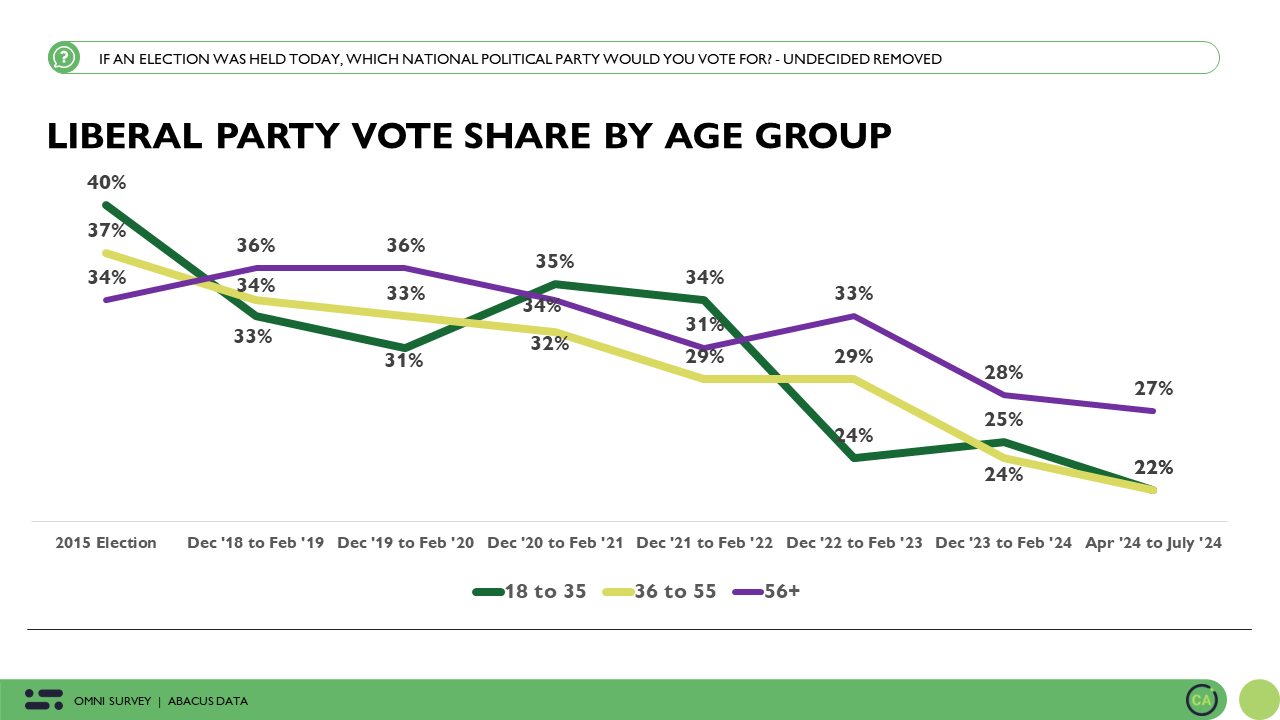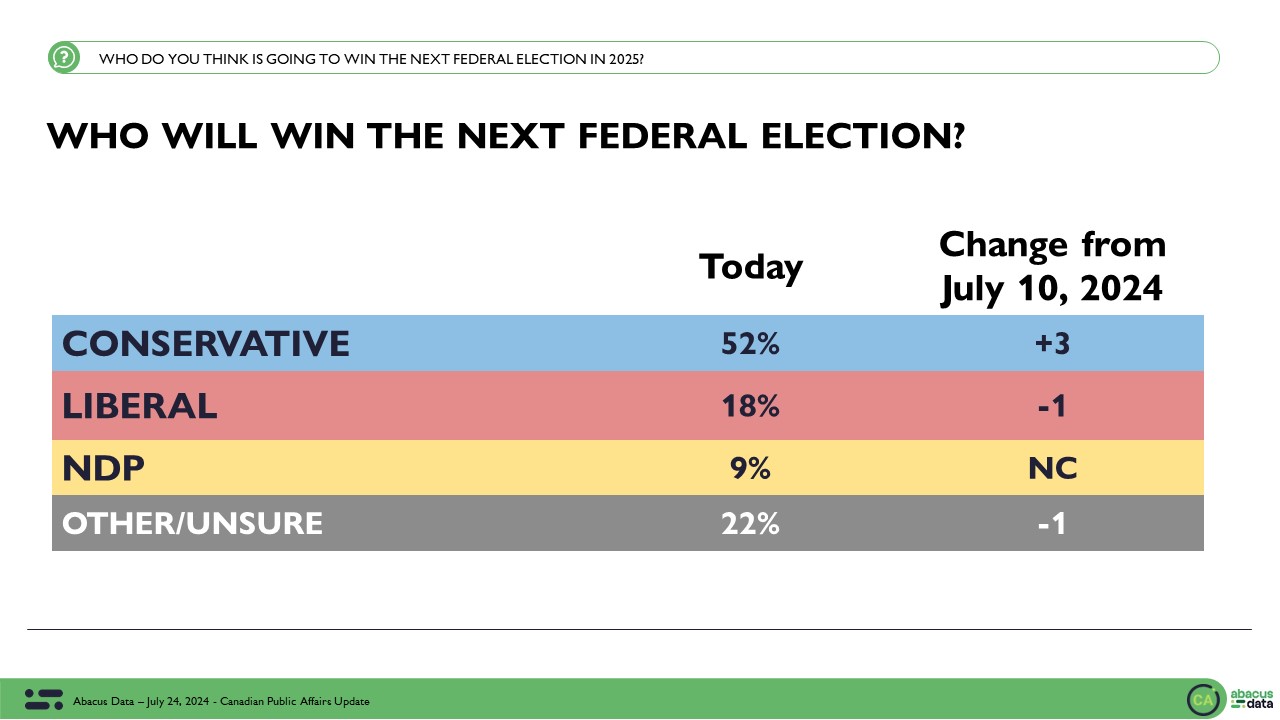Ontario PCs lead by 9 over Liberals as 2022 begins and election looms
January 19, 2022
Ontario is likely heading to the polls in early June 2022 and over the next months, our team will track public opinion and preferences in the lead-up to the campaign.
This is part of our team’s expansion in Toronto. We have opened a new office in downtown Toronto and will be focusing on issues that matter to people living in the GTA and across the province.
Last week we completed a national survey that included an oversample of 1,210 respondents living in Ontario.
Here’s what we found:
TOP PROVINCIAL ISSUES: COVID, INFLATION & HEALTH CARE
When asked to rank the top three issues facing the province from a long list, the COVID-19 pandemic, the rising cost of living and the health care system were in the top 3. Housing affordability and climate change/the environment rounded out the top 5.
Despite severe labour shortages in some sectors, only 9% put it in their top issue. The provincial deficit is a top issue for 11% while education reaches 12%. For 7% the c
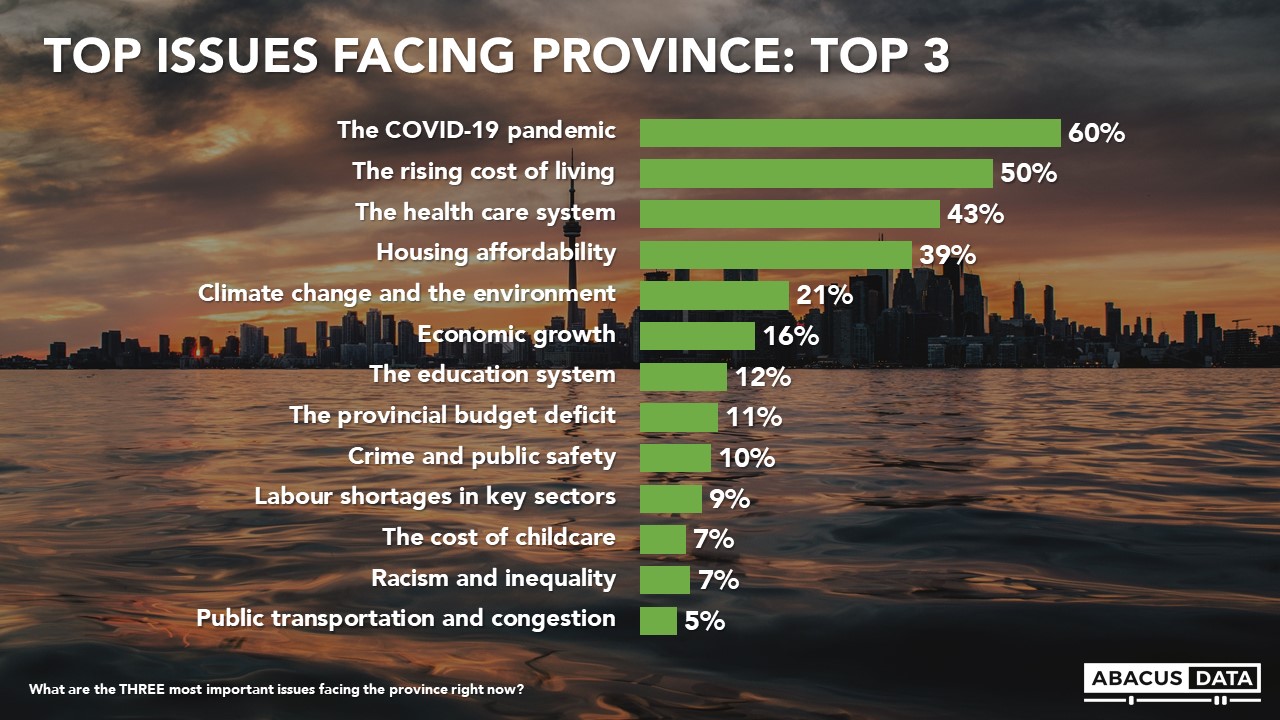
Older Ontarians are more likely to rank the pandemic, the health care system and the deficit than younger ones. Millennials are more concerned about the cost of childcare, racism and inequality, and housing affordability than older Ontarians.

Interestingly, there’s almost no difference on issue priority when comparing those living in the GTA and those in the rest of the province. COVID, inflation, and healthcare top the list for both groups.

For PC Party supporters, the top issues in the province are the same – pandemic, inflation, healthcare, housing affordability and economic growth – but PC supporters are more likely to rate economic growth and the budget deficit as a top issue than other Ontarians and less likely to prioritize climate change, healthcare, and racism/inequality.
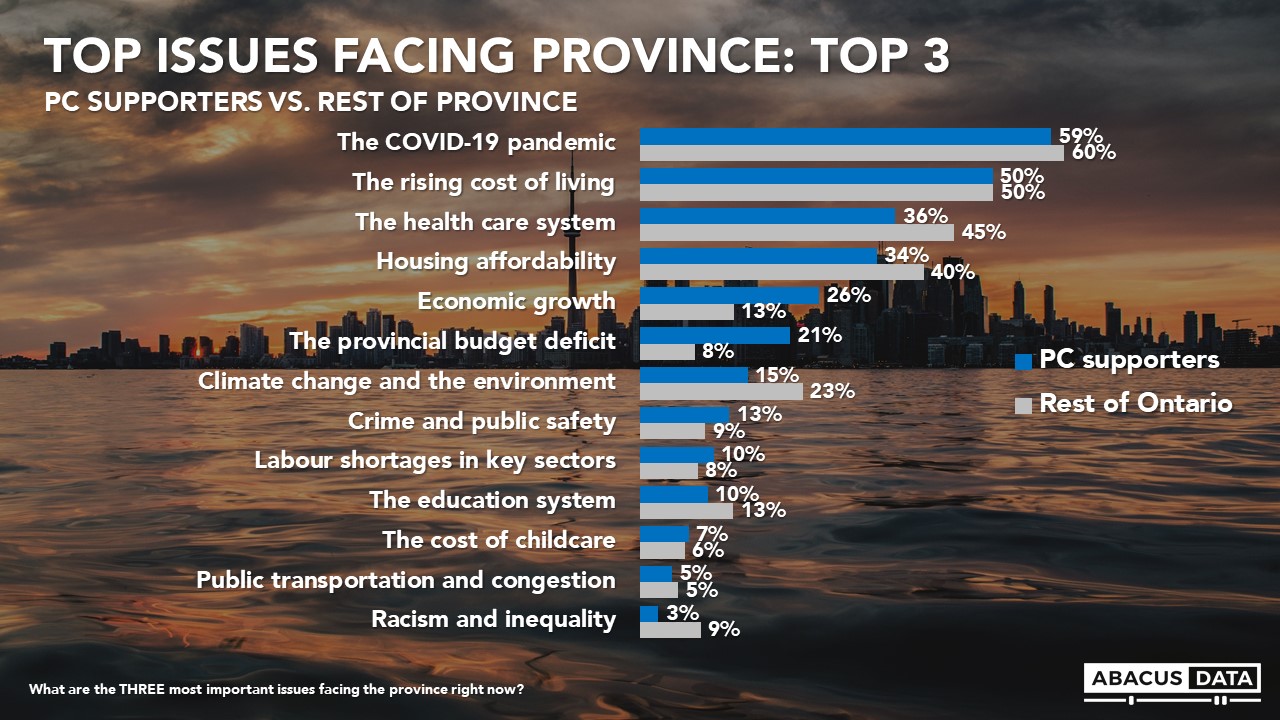
THE ELECTORATE’S MOOD: DESIRE FOR CHANGE
At the start of 2022, 72% of Ontarians feel it is either definitely time for a change in government or it would be nice to have change, but it’s not important to them. In contrast, 28% would like to see the Ford PCs re-elected in the spring.
Most important, 50% definitely want to see a change in government.

To put these numbers in context, the desire for change in the week before the 2018 Ontario election was significantly higher. At that time, 63% definitely wanted a change in government and only 10% definitely wanted to see Kathleen Wynne and the Ontario Liberal’s re-elected.
Moreover, these numbers in Ontario looks similar to the desire for change we saw nationally in the final weekend of the 2021 federal election. At that time, 50% definitely wanted to see a change in government while 19% definitely wanted the federal Liberals re-elected.
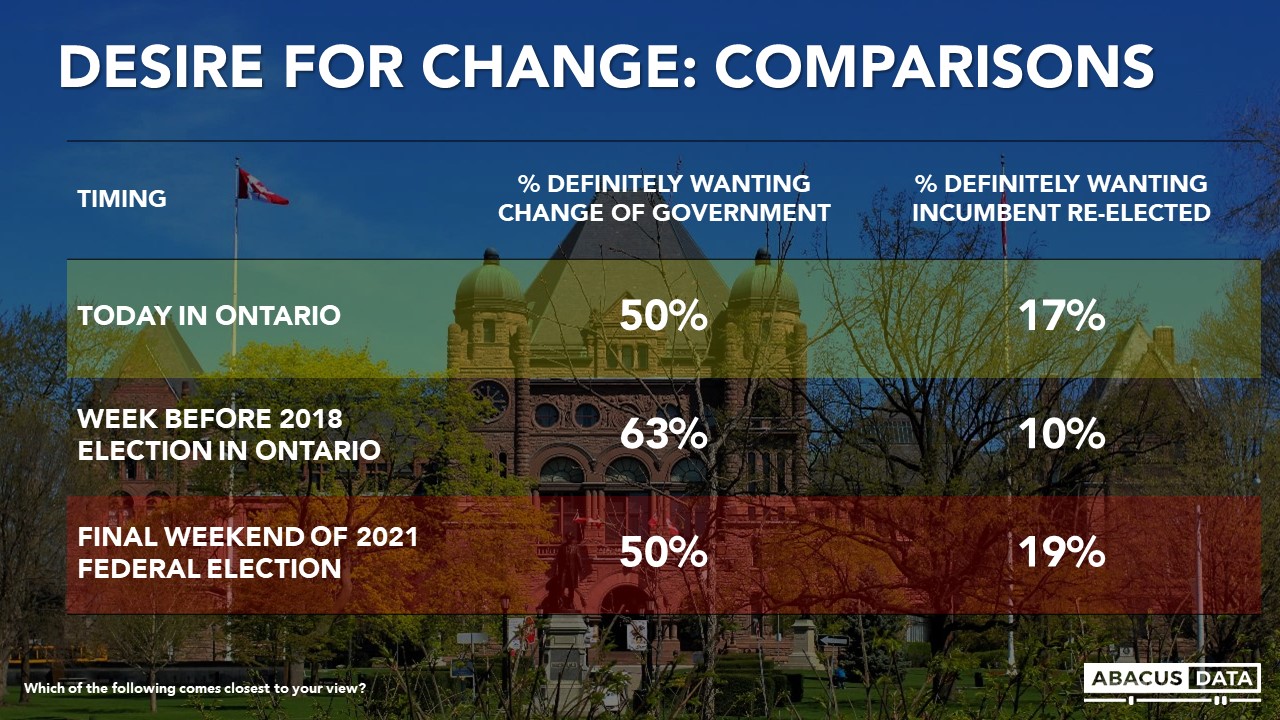
FORD GOVERNMENT PERFORMANCE
What might be driving this desire for change? For one, on the issues that matter most to Ontarians, the Ford government’s performance is perceived to be fairly negative but not enough to be a severe hurdle to re-election.
Take the pandemic for example. This is a top issue to 60% of the electorate and residents are quite divided on the provincial government’s performance. 50% think the Premier and his government have done a poor or very poor job. In contrast, 22% think it has been positive while 25% describe the performance as acceptable.
We see similar numbers for how the government has managed the province’s health care system (good 16%, acceptable 25%, poor 54%) and how it’s dealt with climate change and the environment (14% good, 29% acceptable, 43% poor).
But on two key pocketbook issues that helped the PCs win in 2018, the government’s performance is more negative: the rising cost of living and housing affordability. On both of these issues about 2 in 3 think the government has performed poorly while less than 10% think it has done a good job.

On less salient issues, the government gets more positive marks for its handling of crime/public safety, public transportation, racism/inequality, and economic growth. It’s weaker on childcare, addressing labour shortages, and managing the education system.
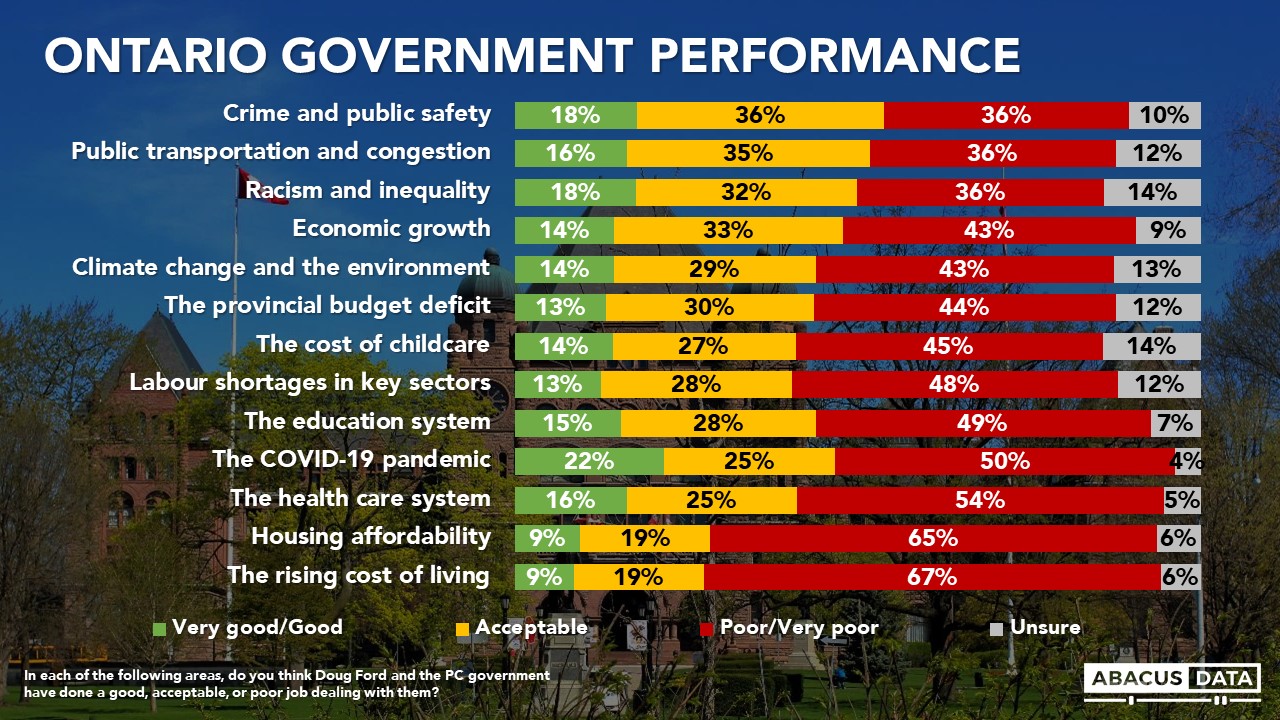
PARTY LEADER IMPRESSIONS
Before asking people for their impression of the four main political party leaders, we asked how well people think they know them.
Not surprising, most feel they know Premier Doug Ford at least pretty well (82%) with 17% saying they don’t know him much or well.
In contrast, NDP and Official Opposition leader Andrea Horwath is known well by 60% of respondents. 40% say they don’t know her that well – this despite being NDP leader for 13 years and leader of the opposition for almost 4.
Ontario Liberal leader Steven Del Duca is much less well-known know with only 38% saying they know him well and 1 in 4 saying they don’t know him much at all.
Green leader Mike Schreiner is the least well-known of the four main party leaders.
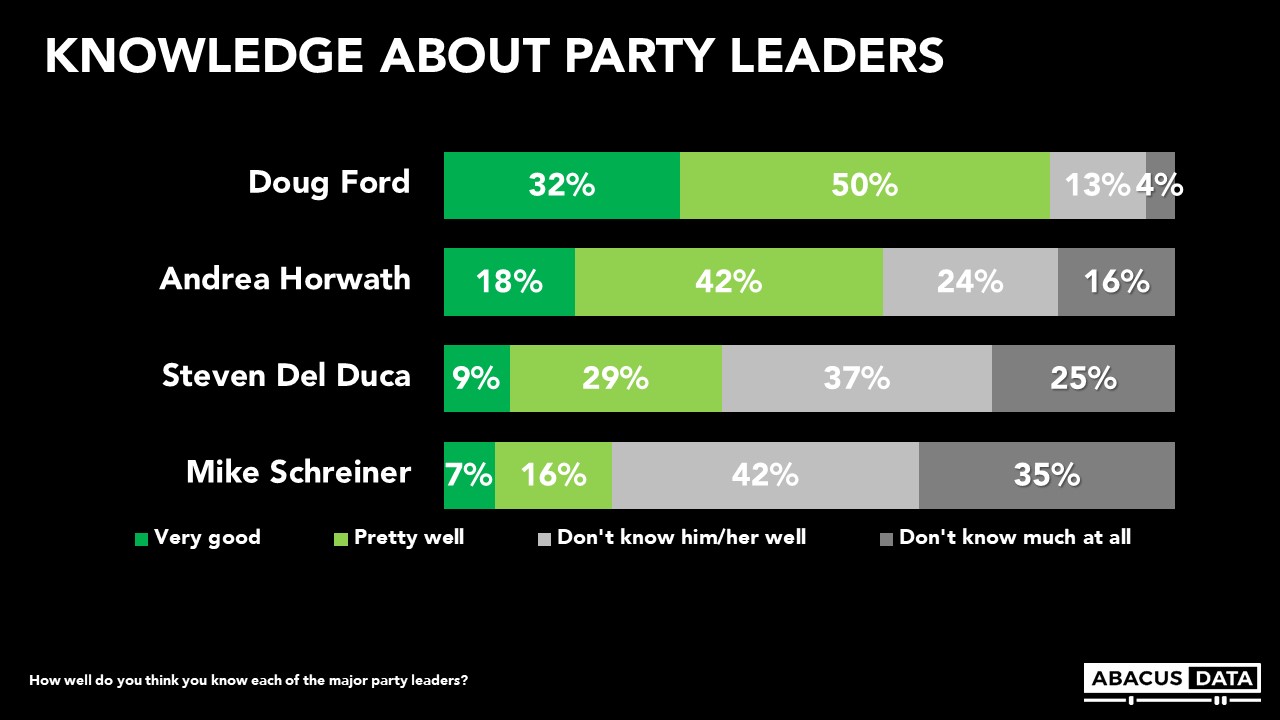
When asked how they feel about the same leaders, none have particularly good images. One in three have a positive impression of Doug Ford and Andrea Horwath while 20% have a positive view of Steven Del Duca. Only 14% view Mike Schreiner positively.
Overall, Doug Ford’s net score is -14, Andrea Horwath’s is +2, Steven Del Ducca’s is -6 while Mike Schreiner’s is -2.

For Doug Ford, his current image is similar to what it was in April 2021 – the last time we asked about him in our public surveys.
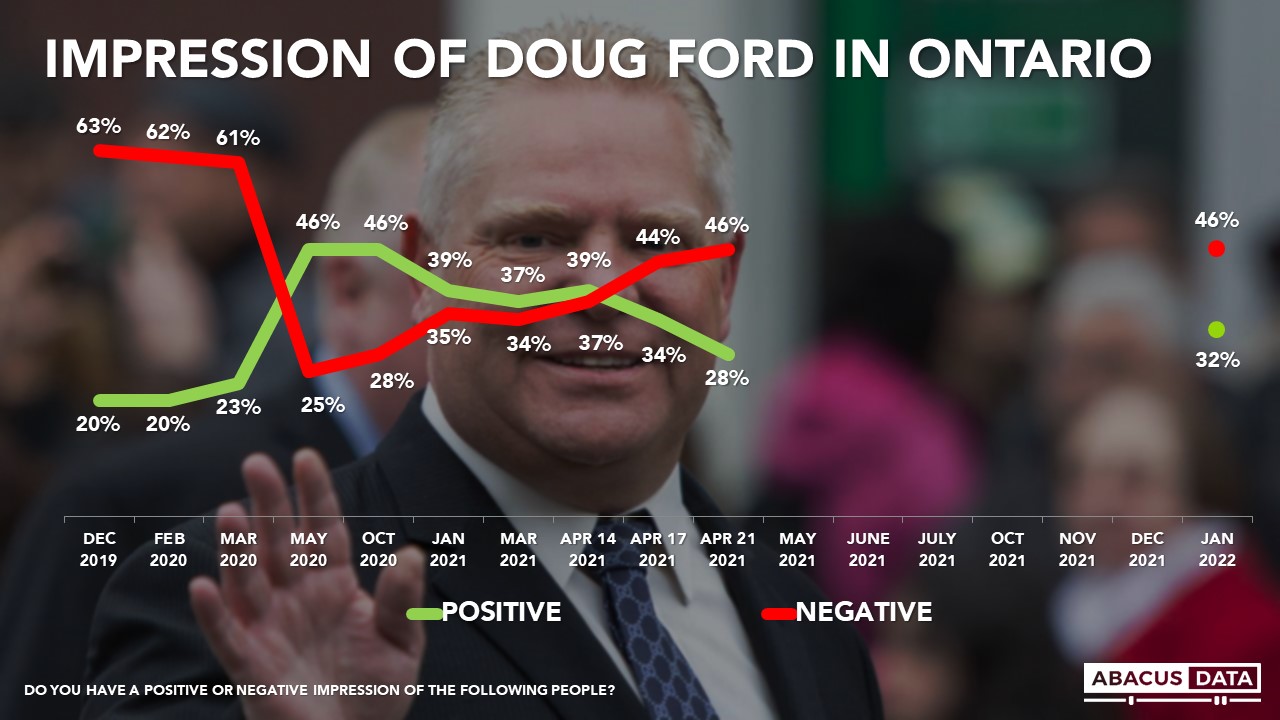
Ford’s personal numbers are fairly consistent across the province.

Not surprisingly, those on the left are far less likely to view the Premier positively than those on the right.
But noteworthy, about 1 in 3 of those who self-identify being on the right say they have a negative view of the Premier. A potential liability as the PCs try to keep the conservative coalition united in the PC Party – especially as two parties on the right try to gain traction.
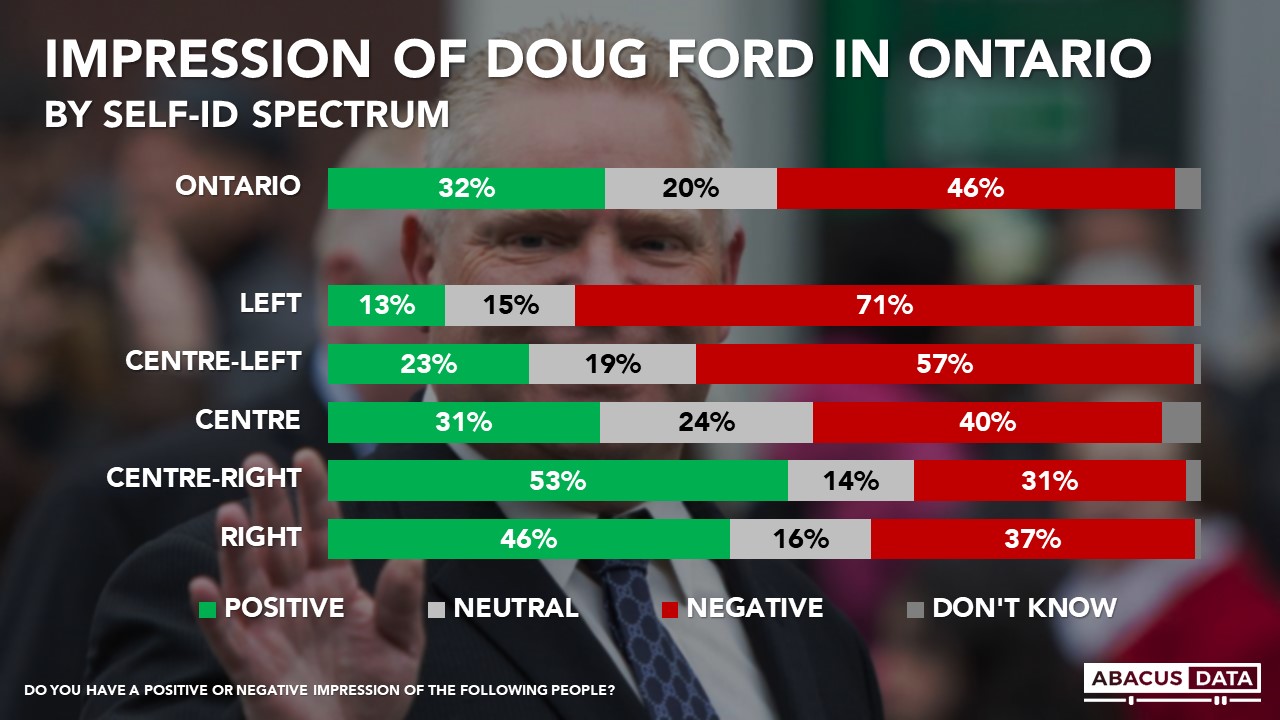
PROVINCIAL VOTE INTENTION
If a provincial election was held today, the PCs would very likely win with 37% of the popular vote. The Ontario Liberals and NDP are in a race for second with the Liberals slightly ahead of the NDP.

Since our last survey in April 2021, when the public reacted quite negatively to new COVID restrictions announced, the PCs are up 3, the Liberals down 7, and the NDP marginally up 2.
Compared with the 2018 provincial election, the PCs are down 3, the Liberals up 8, and the NDP down 9.
Regionally, PC support is fairly consistent across the province. The Liberals have more support in the GTA and Toronto than in other regions. NDP support is fairly consistent across the province.
There is a lot of variation by age. PC support is much higher among those aged 45 and older than those under 45. In fact, at 50%, its support among those 60+ is more than double its support among 18 to 29-year-olds. In an environment where younger electors are less likely to turn out, this is a definite advantage for Doug Ford and the PCs.
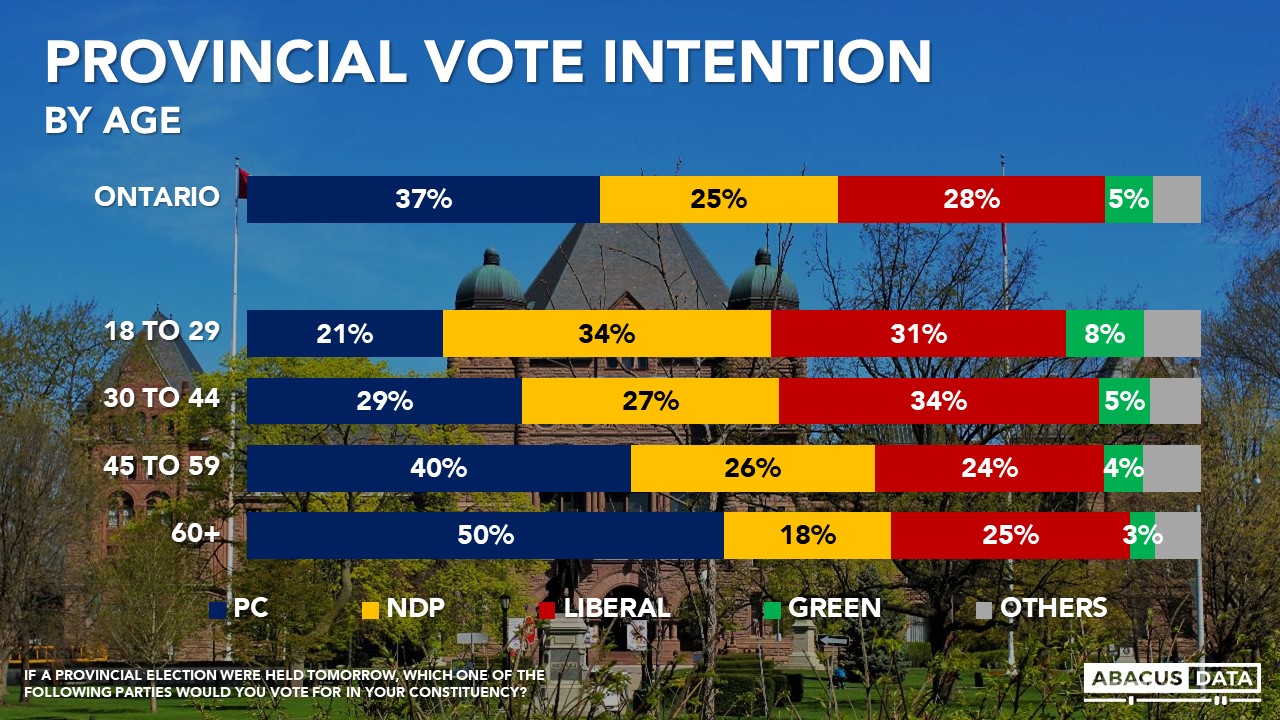
It’s also worth noting that educational attainment doesn’t appear to be a be factor influencing vote intention unlike federally or in other jurisdictions. Party vote shares are fairly consistent across educational groups.

Finally, when we look at provincial vote intentions by reported federal vote in the 2021 Canadian election, we find alignment between Conservative and NDP supporters and their provincial counterparts. Over 80% of federal Conservative and NDP voters say they will vote for the equivalent provincially.
But among federal Liberal supporters, only 2 in 3 say they will vote for the provincial Liberal party with 16% saying they will vote PC and another 16% preferring the Ontario NDP.
If the PCs were to lose those federal Liberal voters and not gain anywhere else, the PCs would lose 6-points and drop down to 31% overall. If the Ontario Liberals gain that 6-points, they would jump into the lead and end with 34% of the popular vote.
These federal Liberal/provincial PC switchers are going to be critical to the PC re-election, especially if they lose voters to the new right-wing parties.
Speaking of which, among federal People’s Party voters, 24% say they would vote PC while more than half would vote for another party. If the PCs can gain even another quarter of these voters, that only would result in an additional 1% vote share gain.
In other words, leakage to the right is a problem but if the PCs lose federal Liberal votes, the damage could be more severe.
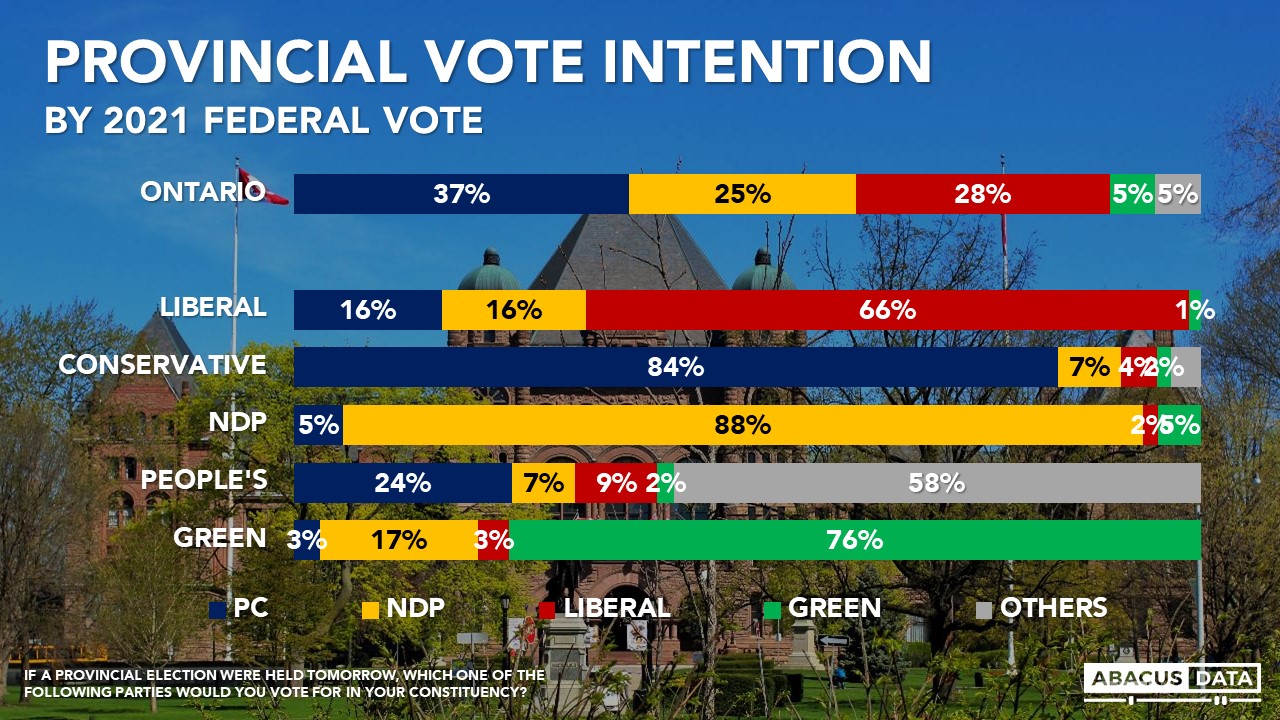
UPSHOT

According to David Coletto: “The PCs start 2022 with the advantage but not one that is not insurmountable. There is widespread dissatisfaction with the Ford government and Premier Ford himself, although not to the extent it was prior to the pandemic. If an election was held today, the PCs would likely win thanks to a divided opposition and strength in all parts of the province. Housing affordability and inflation are two areas where the provincial government performs worst and they become liabilities for the PCs if they don’t have compelling solutions in the lead up to the election.
For the opposition parties, the Liberals are well positioned to become to natural alternative to the PCs again but they have a largely unknown leader in Steven Del Duca. If he can introduce himself positively to Ontarians, the Liberals could make big gains and challenge the Conservatives in the Greater Toronto Area. For the NDP, despite the breakthrough in 2018, Andrea Horwath remains unknown and poorly defined to millions of Ontarians and the party has fallen behind the NDP.
In order to defeat the PCs, the opposition parties will need to do two things. First, increase the desire for change in the province and two consolidate support more effectively around one alternative. Right now, the electorate is both insufficiently angry at the Ford PCs and not excited about any of the alternatives. Ford’s surest path to re-election is to not make waves, reinforce his right flank while hoping the divided centre-left continues
METHODOLOGY
The survey was conducted with 1,210 Ontario residents over 18 from January 7 to 12, 2022. A random sample of panelists were invited to complete the survey from a set of partner panels based on the Lucid exchange platform. These partners are typically double opt-in survey panels, blended to manage out potential skews in the data from a single source.
The margin of error for a comparable probability-based random sample of the same size is +/- 2.9%, 19 times out of 20.
The data were weighted according to census data to ensure that the sample matched Ontario’s population according to age, gender, educational attainment, and region. Totals may not add up to 100 due to rounding.
Abacus Data follows the CRIC Public Opinion Research Standards and Disclosure Requirements that can be found here: https://canadianresearchinsightscouncil.ca/standards/
ABOUT ABACUS DATA
We are the only research and strategy firm that helps organizations and leaders respond to the disruptive risks and opportunities in a world where demographics and technology are changing more quickly than ever.
We are an innovative, fast-growing public opinion and marketing research consultancy. We use the latest technology, sound science, and deep experience to generate top-flight research-based advice to our clients. We offer global research capacity with a strong focus on customer service, attention to detail and exceptional value.
We were one of the most accurate pollsters conducting research during the 2021 Canadian election following up on our outstanding record in 2019.
Contact us with any questions.
Find out more about how we can help your organization by downloading our corporate profile and service offering.


